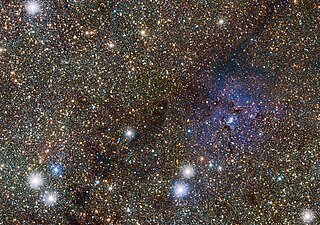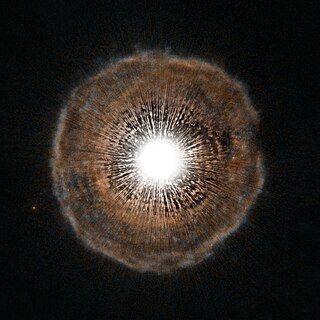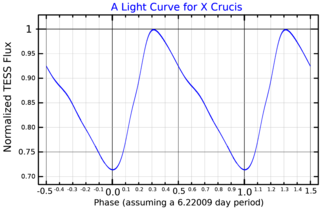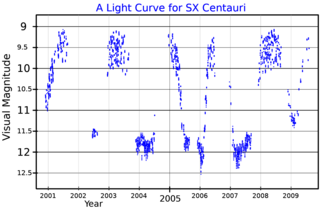
A variable star is a star whose brightness as seen from Earth changes with time. This variation may be caused by a change in emitted light or by something partly blocking the light, so variable stars are classified as either:

Chi Cygni is a Mira variable star in the constellation Cygnus, and also an S-type star. It is around 500 light years away.

RV Tauri variables are luminous variable stars that have distinctive light variations with alternating deep and shallow minima.

HD 84810, also known as l Carinae, is a star in the southern constellation of Carina. Its apparent magnitude varies from about 3.4 to 4.1, making it readily visible to the naked eye and one of the brightest members of Carina. Based upon parallax measurements, it is approximately 1,600 light-years from Earth.

The unqualified term instability strip usually refers to a region of the Hertzsprung–Russell diagram largely occupied by several related classes of pulsating variable stars: Delta Scuti variables, SX Phoenicis variables, and rapidly oscillating Ap stars (roAps) near the main sequence; RR Lyrae variables where it intersects the horizontal branch; and the Cepheid variables where it crosses the supergiants.

A yellow supergiant (YSG) is a star, generally of spectral type F or G, having a supergiant luminosity class. They are stars that have evolved away from the main sequence, expanding and becoming more luminous.

V1401 Aquilae is a single, semi-regular pulsating star in the equatorial constellation of Aquila. It has the designation HD 190390 from the Henry Draper Catalogue, and was formerly designated 64 Sagittarii. The evolutionary status of the star is unclear, and it has been classified as a post-AGB object, a UU Herculis variable, or belonging to the W Virginis variable subclass of the type II Cepheids. It is dimly visible to the naked eye with an apparent visual magnitude that fluctuates around 6.38. Based on parallax measurements, it is located at a distance of approximately 2,380 light years. It lies 21.5° from the galactic plane.

TT Aquilae is a Classical Cepheid variable star in the constellation Aquila.
T Antliae is a Classical Cepheid variable star that is between 10 and 12,000 light-years away from the Sun in the constellation of Antlia. A yellow-white supergiant with a spectral type of F6Iab, it ranges between apparent magnitude 8.86 and 9.76 over a period of 5.89820 days.

Classical Cepheids are a type of Cepheid variable star. They are young, population I variable stars that exhibit regular radial pulsations with periods of a few days to a few weeks and visual amplitudes ranging from a few tenths of a magnitude up to about 2 magnitudes. Classical Cepheids are also known as Population I Cepheids, Type I Cepheids, and Delta Cepheid variables.

U Camelopardalis is a semiregular variable star in the constellation Camelopardalis. Based on parallax measurements made by the Hipparcos spacecraft, it is located about 3,000 light-years away from the Earth. Its apparent visual magnitude is about 8, which is dim enough that it cannot be seen with the unaided eye.

W Virginis is the prototype W Virginis variable, a subclass of the Cepheid variable stars. It is located in the constellation Virgo, and varies between magnitudes 9.46 and 10.75 over a period of approximately 17 days.

Kappa Pavonis is a variable star in the constellation Pavo. It is the brightest W Virginis variable in the sky.

SV Vulpeculae is a classical Cepheid variable star in the constellation Vulpecula. It is a supergiant at a distance of 8,700 light years.

RT Trianguli Australis, or RT TrA, is a BL Herculis variable in the constellation of Triangulum Australe.

X Crucis is a classical Cepheid variable star in the southern constellation of Crux.

R Sagittae is an RV Tauri variable star in the constellation Sagitta that varies from magnitude 8.0 to 10.5 in 70.77 days. It is a post-AGB low mass yellow supergiant that varies between spectral types G0Ib and G8Ib as it pulsates. Its variable star designation of "R" indicates that it was the first star discovered to be variable in the constellation. It was discovered in 1859 by Joseph Baxendell, though classified as a semi regular variable until RV Tauri variables were identified as a distinct class in 1905.

U Monocerotis is a pulsating variable star and spectroscopic binary in the constellation Monoceros. The primary star is an RV Tauri variable, a cool luminous post-AGB star evolving into a white dwarf.

SX Centauri is a variable star in the constellation Centaurus. An RV Tauri variable, its light curve alternates between deep and shallow minima, varying its apparent magnitude from 9.1 to 12.4. From the period-luminosity relationship, it is estimated to be around 1.6 kpc from Earth. Gaia Data Release 2 gives a parallax of 0.2175 mas, corresponding to distance of about 4,600 pc.

FG Virginis is a well-studied variable star in the equatorial constellation of Virgo. It is a dim star, near the lower limit of visibility to the naked eye, with an apparent visual magnitude that ranges from 6.53 down to 6.58. The star is located at a distance of 273.5 light years from the Sun based on parallax measurements, and is drifting further away with a radial velocity of +16 km/s. Because of its position near the ecliptic, it is subject to lunar occultations.




















